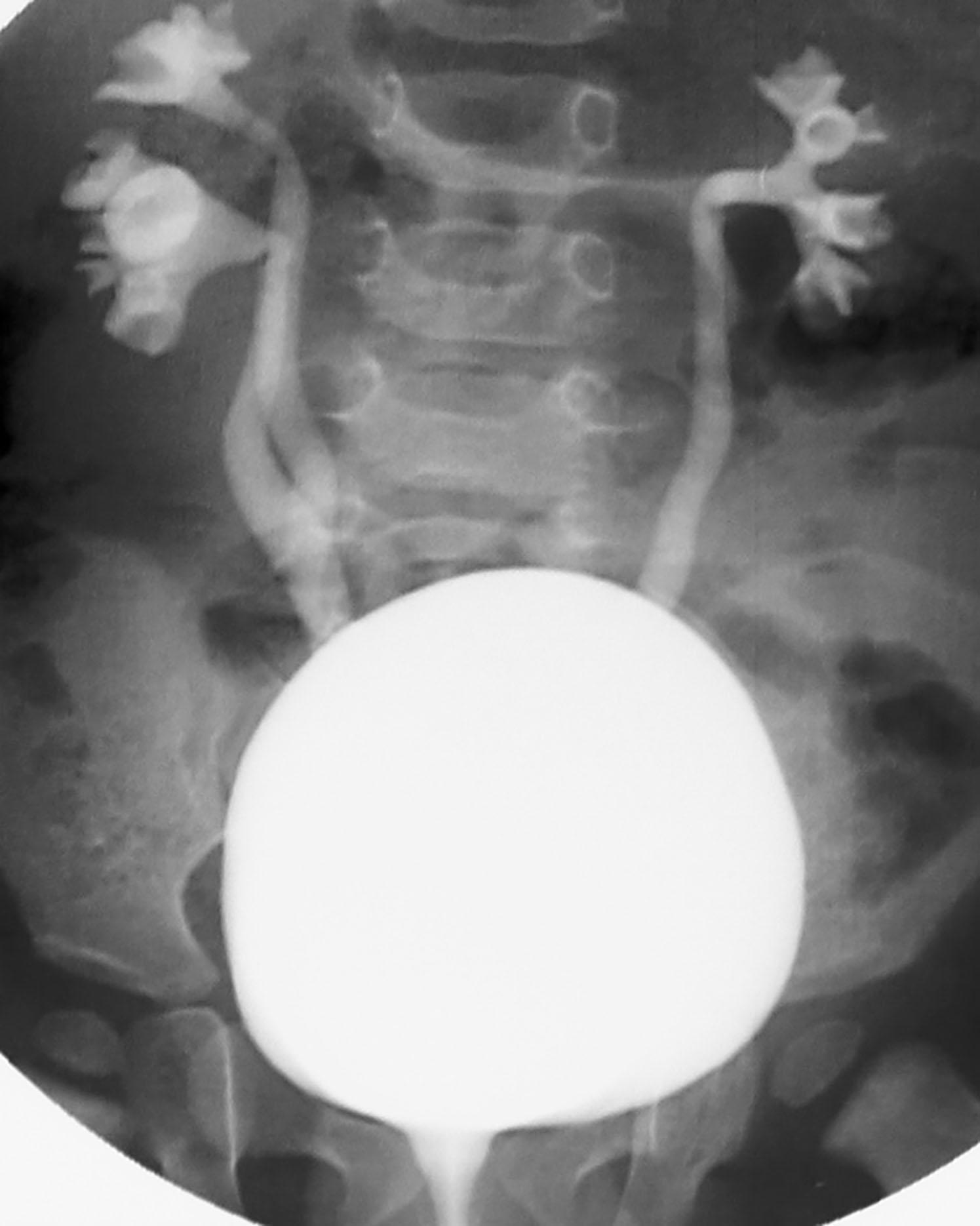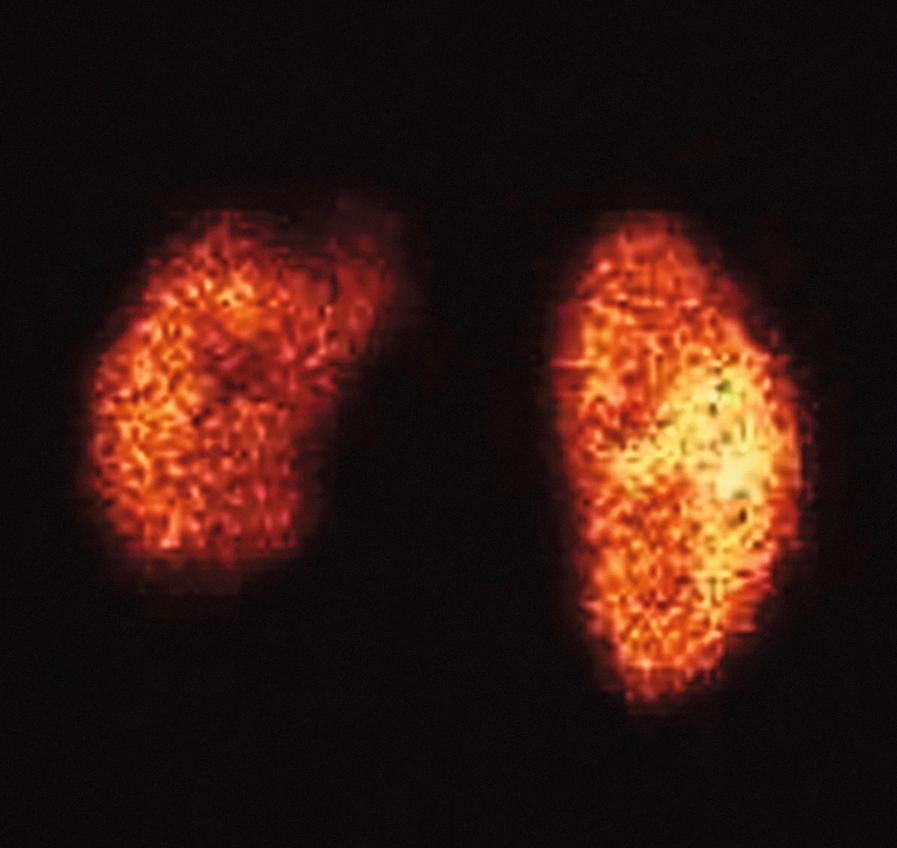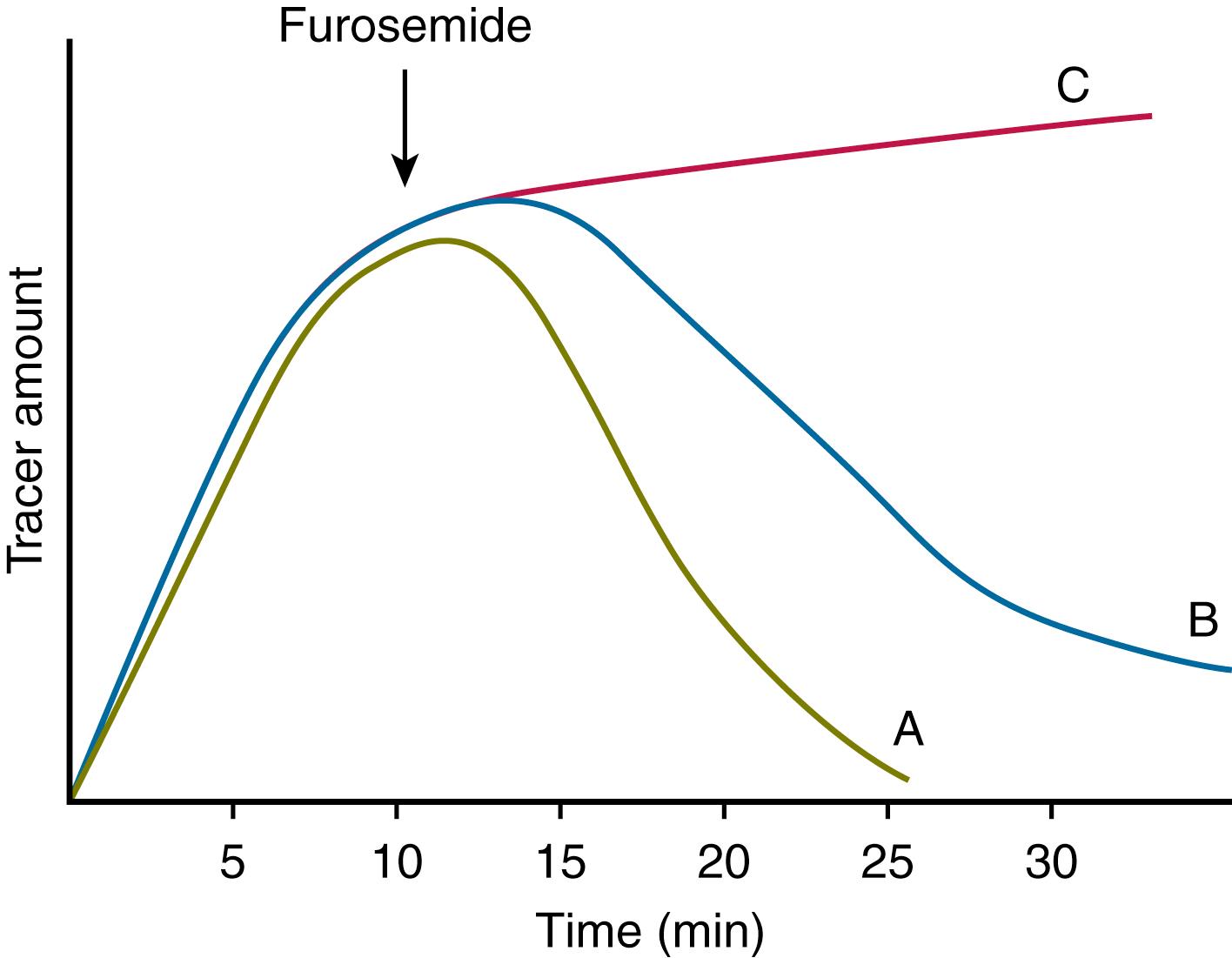Physical Address
304 North Cardinal St.
Dorchester Center, MA 02124
After reading this chapter you should be able to assess, diagnose and manage:
congenital anomalies of the kidney and urinary tract
acute kidney injury and chronic kidney disease
urinary tract infections
renal tubular disorders
nephritic and nephrotic syndrome
enuresis
Proteinuria above 100 mg/m 2 /day reflects abnormal excretion at either the glomerular or tubular level. Children with heavy proteinuria, as seen in nephrotic syndrome, will excrete over 1000 mg/m 2 /day of protein.
Glomerular proteinuria will usually produce large protein molecules such as albumin in the urine whereas tubular proteinuria is the result of an inability to reabsorb low molecular weight proteins and is often seen with glycosuria and bicarbonate losses. Small proteins are not detected by standard urinary dipstick testing ( Table 20.1 ).
| Investigation | Rationale for investigation | |
|---|---|---|
| urine | urinalysis | haematuria, red cell casts (seen in glomerulonephritis); pyuria |
| protein: creatinine ratio (random sample) | quantifies protein output | |
| blood | electrolytes | assess renal function |
| urea | assess renal function | |
| creatinine | assess renal function | |
| C3 and C4 | C3 low post-streptococcal; C3 and C4 low in lupus nephritis |
|
| protein and albumin | low levels supporting protein leak | |
| lipids | elevated cholesterol and triglycerides with nephrotic syndrome | |
| ANA | lupus nephritis | |
| ASOT | raised following streptococcal infection | |
| hepatitis B and C | assess potential liver disease | |
| imaging | renal ultrasound | parenchymal damage or congenital anomalies |
Microscopic haematuria describes the presence of more than five red cells per mm 3 of urine whilst macroscopic haematuria refers to urine that is visibly discoloured ( Table 20.2 ).
| Investigation | Rationale for investigation | |
|---|---|---|
| urine | urinalysis | red cell casts (seen in glomerulonephritis); pyuria |
| culture | identifies urinary tract infection | |
| urine protein: creatinine ratio (random sample) | quantifies protein output | |
| blood | electrolytes | assess renal function |
| urea | assess renal function | |
| creatinine | assess renal function | |
| clotting | exclude abnormal clotting | |
| C3 and C4 | C3 low post-streptococcal; C3 and C4 low in lupus nephritis |
|
| protein and albumin | low levels supporting leak | |
| lipids | elevated cholesterol and triglycerides with nephrotic syndrome | |
| ANA | usually raised in lupus nephritis | |
| ASOT | raised following streptococcal infection | |
| microbiology | stool culture | if HUS suspected |
| imaging | renal ultrasound | parenchymal damage or congenital anomalies |
Causes of haematuria include:
UTI
malignancy
renal calculi
glomerulonephritis
IgA nephropathy
Alport syndrome
clotting abnormalities
trauma
haemolytic uraemic syndrome
Urine may be discoloured for reasons other than haematuria and recognition of these potential causes may reduce the need for further assessment.
haemoglobin – haemolysis
myoglobin – rhabdomyolysis
food – beetroot, food dyes
drugs – rifampicin, nitrofurantoin, metronidazole
metabolic – porphyria
urates – crystals in neonates
Imaging of the renal tract provides significant information to help diagnosis and management, but the interpretation of all radiological imaging relating to the renal tract is the responsibility of the radiologist.
Plain abdominal x-rays —has a limited role in management of renal conditions and their previous role has now been superseded by ultrasonography.
Renal ultrasound —a valuable, noninvasive technique that, in experienced hands, can provide a great detail of information about the structure of kidneys, ureters and bladder.
Micturating cysto-urethrogram (MCUG) investigations ( Figure 20.1 )—contrast-enhanced images that are produced by introducing radiocontrast material into the bladder through a urinary catheter. The catheter is then removed and abdominal images obtained whilst the child attempts to void urine. Vesico-ureteric reflux, anatomical abnormalities and urethral valves can all be identified by this technique.

DMSA investigations ( Figure 20.2 )—radionuclide static scans used to provide information on the distribution of renal parenchymal tissue. The tracer is injected intravenously and the patient is scanned to identify uptake. The scans are able to identify renal agenesis, scarring and dysplastic kidneys and can also identify ectopic renal tissue.

DTPA and MAG3 investigations ( Figure 20.3 ) are radionuclide dynamic scans used to provide information on renal function although the MAG3 scan can also identify some changes in renal parenchymal tissue. The tracer is injected intravenously and the patient is scanned at intervals to record the rate of excretion. The scans can identify delayed excretion of the tracer in each kidney and so assess obstruction to urine flow.

Some congenital anomalies of the kidney and urinary tract may be identified antenatally, others are evident at birth whilst some present later. Many syndromic conditions have associated abnormalities of the renal tract.
Hydronephrosis may be associated with a hydroureter and is usually due to obstruction at the pelviureteric (PUJ) or vesicoureteric junctions. It may also be the result of reflux of urine from the bladder into the ureter and kidneys.
| Site | Aetiology |
|---|---|
| renal pelvis | congenital, calculi, tumour, infection |
| pelviureteric junction | congenital stenosis, calculi, trauma |
| ureter | megaureter with obstruction, ectopic ureter, ureterocoele, calculi, tumour |
| bladder | neurogenic bladder, tumours, ectopic ureter |
| urethra | posterior urethral valve, strictures, phimosis |
Hydronephrosis detected antenatally is usually mild and resolves without intervention although monitoring is undertaken to ensure resolution. Significant hydronephrosis needs investigation with MAG3 or MCUG to ascertain whether the appearances are the result of obstruction or reflux. Children with significant hydronephrosis are likely to need surgical correction.
The obstruction is usually identified in antenatal scans and is generally due to congenital stenosis. Mild dilatation does not need extensive investigations and usually resolves whilst most children with significant dilatation will require a pyeloplasty.
Posterior urethral valves are the most common cause of bladder outlet obstruction in boys. These abnormal valves attach to the urethral wall leading to obstruction and dilatation of the posterior urethra. Over time the bladder detrusor muscle becomes hypertrophied.
Posterior urethral valves are usually suspected when antenatal scans show bilateral hydronephrosis. Severe obstruction may be associated with oligohydramnios which then leads to lethal pulmonary hypoplasia, and most will have some degree of renal dysplasia. Urgent USS and MCUG will identify the obstruction at the bladder outflow.
A urethral catheter should be inserted immediately after birth in those where hydronephrosis is identified antenatally and prophylactic antibiotics administered until investigations are completed. Once the presence of the valves is confirmed they can then be ablated via a cystoscope.
Autosomal dominant polycystic kidney disease is the most common inherited renal disease and usually presents in late adolescence or adulthood. Proteinuria and hypertension may develop along with cysts in the liver and pancreas. The screening of asymptomatic family members should be offered as some may have clinically silent disease. End stage renal failure occurs early in the severe type, whereas others may develop failure in later adulthood.
Autosomal recessive polycystic kidney disease can be severe and is identified antenatally with oligohydramnios and pulmonary hypoplasia. These clinical features are consistent with Potter’s syndrome and the babies die early in the neonatal period. Those with milder disease can present later with symptoms of progressive deterioration in renal function with polyuria and polydipsia, metabolic acidosis and hypertension. The kidneys are usually enlarged on examination.
The main aim is to control the hypertension and manage the renal failure with some patients needing renal and liver transplantation at a later date.
Acute kidney injury (AKI) describes a sudden loss of kidney function resulting in the retention of nitrogenous wastes and the inability to regulate fluid and electrolyte haemostasis. The conditions that cause AKI are:
prerenal—hypovolaemia or hypotension
renal abnormalities—vascular, glomerular, tubular or interstitial
post renal—congenital or acquired obstruction
Acute kidney injury is identified following the investigations of the conditions presented below. Further investigations will usually be required and can be found under lists for proteinuria and haematuria ( table 20.1 and 20.2 ).
Prerenal failure is mainly due to hypovolaemia and needs urgent correction with fluid and circulatory support if associated with hypotension.
Primary renal failure results in circulatory overload and retention of fluid and hence fluid boluses are counterproductive. Restriction of fluids with a diuretic challenge may restore urine output, but if oliguria persists, fluid is restricted to that needed to replace insensible loss plus urine output. Nephrotoxic medications should be avoided and all medications with renal excretion need their dose adjusted and, in some situations, levels monitored. Most children will respond to conservative management of fluid balance and a high-calorie, normal protein feed. However, these measures may not be adequate and dialysis will then be required.
Post renal failure needs the relief of the obstruction by bladder catheterisation or nephrostomy and any required surgical correction undertaken at a later date.
Indications for dialysis are:
the failure of conservative management
fluid overload resulting in pulmonary oedema
severe metabolic acidosis
severe electrolyte imbalance
hyperkalaemia
multisystem failure
Long-term follow up is usually required for those patients with AKI as any potential damage can result in hypertension and proteinuria.
One of the main causes of acute kidney injury in children is haemolytic uraemic syndrome (HUS) which is diagnosed by the presence of a microangiopathic haemolytic anaemia, thrombocytopenia and acute kidney injury. HUS is seen most commonly following infection with Shiga toxin-producing Escherichia coli although other organisms such as Streptococcus pneumoniae have been implicated.
The child usually has usually had a preceding illness with abdominal pain, vomiting and bloody diarrhoea and continues to deteriorate clinically. Hypertension is a common finding on examination. Initial investigations will identify haemolytic anaemia and fragmented red cells, thrombocytopenia and AKI along with a stool culture showing E. coli O157.H7 . Clotting studies are usually normal in HUS and helps to distinguish it from DIC.
The initial management of children with HUS is supportive, and referral to paediatric nephrology services is advised as renal dialysis may be required. It is also important to notify the local Public Health services as a source of the infection should be investigated.
Chronic kidney disease (CKD) is the result of a progressive loss of renal function and is diagnosed when the GFR falls below 60 ml/min per 1.73 m 2 for more than 3 months.
The common causes of CKD are:
congenital—malformations, obstructive uropathy, renal dysplasia, reflux nephropathy
metabolic—cystinosis, oxalosis, polycystic kidney disease
glomerulonephritis—focal segmental glomerulosclerosis, congenital nephrotic syndrome, IgA nephropathy
CKD in the earlier stages is mainly asymptomatic but patients with later stage disease present with:
anorexia and lethargy
polyuria and polydipsia
restricted growth
anaemia
hypertension
Late features include acidosis, hyperkalaemia, uraemia, left ventricular failure and pulmonary oedema.
These are aimed at identifying the underlying cause of the presenting chronic renal failure and excluding any potential causes of acute kidney injury.
It is not usually possible to reverse the renal damage seen with CKD and hence the aim is to prevent further deterioration of renal function by supportive measures. Ensuring good nutrition, optimal growth, control of hypertension and treatment of anaemia are all required. Any obstructions of the renal tract needs to be relieved and the development of renal osteodystrophy minimised by keeping calcium, phosphate, PTH and alkaline phosphatase within normal range.
Children and young people with CKD are at risk of anaemia and are usually given iron supplements and erythropoietin. They are also at risk of developing metabolic bone disease which is identified by hyperphosphataemia and hypocalcaemia and consequently require phosphate binders, calcium supplements and vitamin D analogues (1-alfacalcidol, 1,25 dihydroxycholecalciferol).
If CKD progress to end-stage kidney disease, renal replacement therapy—renal transplant or dialysis—is required and is usually started when the child or young person becomes symptomatic or the biochemical parameters reach unacceptable levels. A living-donor renal transplant is the preferred option; otherwise, a dialysis programme is offered.
Haemodialysis is undertaken at least three times a week; each session lasts 3–5 hours and the patient and their families usually have to travel some distance to the dialysis centre. The treatment therefore makes significant demands on the patient and their family and both home haemodialysis or peritoneal dialysis have been used to mitigate this disruption. Successful transplant offers a return to near-normal life although immunosuppressive medications are needed for life.
Urinary tract infection (UTI) is one of the most common causes of bacterial infections in childhood and is more common in girls except in early infancy. It can be easily missed as the symptoms are often nonspecific. UTI in the young is known to cause renal scarring leading to long-term morbidity including hypertension and renal impairment, and a child with repeated urinary tract infections may have an underlying renal tract anomaly and needs investigation. Common causative organisms include E. coli, proteus and pseudomonas.
UTI should be suspected in any child presenting with fever and nonspecific symptoms. Recognised added symptoms by age are:
infants—fever >38 o C, irritability, vomiting and, rarely, septicaemia
preschool children—may complain of abdominal pain, smelly urine and dysuria
older children—frequency, dysuria, urgency and enuresis
Become a Clinical Tree membership for Full access and enjoy Unlimited articles
If you are a member. Log in here